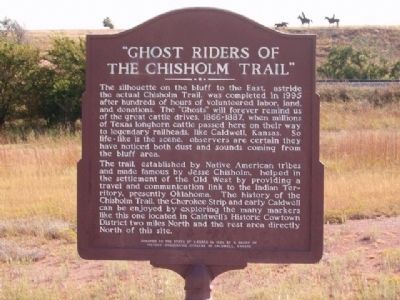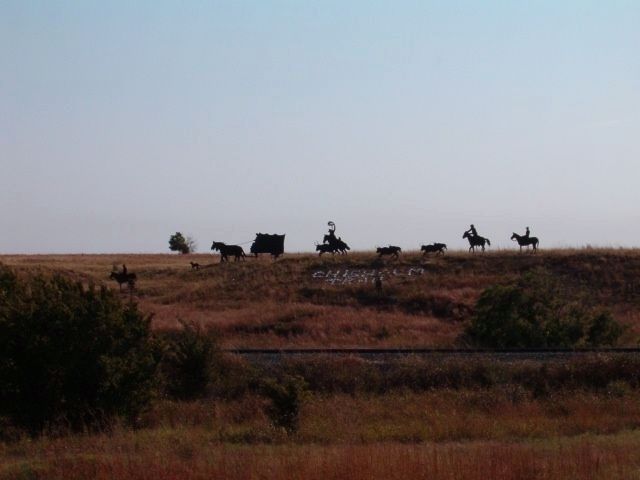Near Caldwell in Sumner County, Kansas — The American Midwest (Upper Plains)
Ghost Riders of the Chisholm Trail
The trail, established by Native American tribes and made famous by Jesse Chisholm, helped in the settlement of the Old West by providing a travel and communication link to the Indian Territory, presently Oklahoma. The history of the Chisholm Trail, the Cherokee Strip and early Caldwell can be enjoyed by exploring the many markers like this one located in Caldwell's Historic Cowtown District two miles north and the rest area directly North of this site.
Erected 1995 by a group of history-preserving citizens of Caldwell, Kansas.
Topics. This historical marker is listed in these topic lists: Notable Places • Roads & Vehicles. A significant historical year for this entry is 1995.
Location. 37° 0.08′ N, 97° 36.475′ W. Marker is near Caldwell, Kansas, in Sumner County. Marker is on S. Fall Creek Road (U.S. 81), on the left when traveling south. Touch for map. Marker is in this post office area: Caldwell KS 67022, United States of America. Touch for directions.
Other nearby markers. At least 8 other markers are within 2 miles of this marker, measured as the crow flies. Caldwell and the Chisholm Trail (approx. 0.4 miles away); The Grand Opera House (approx. 2 miles away); The Legend of Mount Lookout / Gunfire Kills Lawman (approx. 2 miles away); Caldwell "The Border Queen" / On This Site (approx. 2.1 miles away); Chisholm Trail (approx. 2.1 miles away); The Stock Exchange Bank (approx. 2.1 miles away); Chisholm (approx. 2.1 miles away); The Railroad Influence (approx. 2.1 miles away). Touch for a list and map of all markers in Caldwell.
More about this marker. Looking from the road towards the east.
Also see . . .
1. Wikipedia Entry. “On the long trips — up to two months — the cattlemen faced many difficulties. They had to cross major rivers such as the Arkansas and the Red, and innumerable smaller creeks, plus the topographic challenges
of canyons, badlands and low mountain ranges. The weather was less than ideal. In addition to these natural dangers, rustlers and occasional conflicts with Native Americans erupted. The latter demanded that drovers, the trail bosses, pay a toll of 10 cents a head to local tribes for the right to cross Indian lands (Oklahoma at that time was Indian Territory, governed from Fort Smith, Arkansas). The half-wild Texas Longhorn cattle were contrary and prone to stampede with little provocation.” (Submitted on March 1, 2014.)
2. Along the Chisholm Trail. “Not only cut the critter out of the herd, but when you make your cast with your lasso, that hoss knowed just the right second when to sit down to keep the critter from dragging the hoss, and, if the hoss sat down too soon, there’d be so much slack in the rope the critter’d have leverage to pull with. Then, if the hoss sat down a little late, it’d be just in the act of going down and’d have the least resistance it’d have at any time. You see, that’s the reason the cowpunchers loved their hosses so much when they had one that was a good one. When he had a good hoss, his work was
so much easier that it just made all the difference in the world.” (Submitted on March 1, 2014.)
Credits. This page was last revised on March 20, 2021. It was originally submitted on September 20, 2008, by Gary D. Carter of King George, Virginia. This page has been viewed 3,524 times since then and 141 times this year. It was the Marker of the Week March 2, 2014. Photos: 1, 2. submitted on September 20, 2008, by Gary D. Carter of King George, Virginia. 3. submitted on March 1, 2014. 4. submitted on September 20, 2008, by Gary D. Carter of King George, Virginia. • Kevin W. was the editor who published this page.



